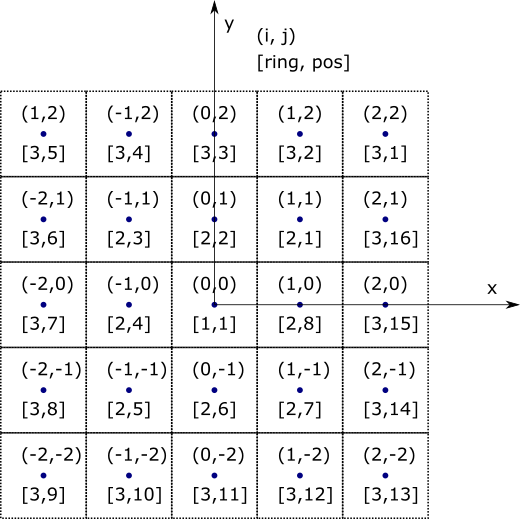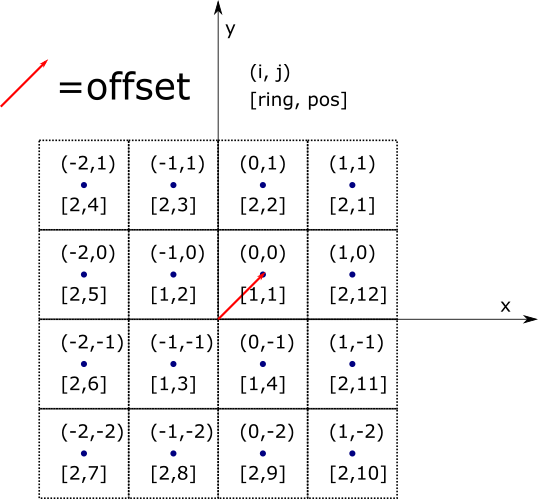armi.reactor.grids.cartesian module
- class armi.reactor.grids.cartesian.CartesianGrid(unitSteps=(0, 0, 0), bounds=(None, None, None), unitStepLimits=((0, 1), (0, 1), (0, 1)), offset=None, geomType='', symmetry='', armiObject=None)[source]
Bases:
StructuredGridGrid class representing a conformal Cartesian mesh.
It is recommended to call
fromRectangle()to construct, rather than directly constructing with__init__Notes
In Cartesian, (i, j, k) indices map to (x, y, z) coordinates. In an axial plane (i, j) are as follows:
(-1, 1) ( 0, 1) ( 1, 1) (-1, 0) ( 0, 0) ( 1, 0) (-1,-1) ( 0,-1) ( 1,-1)
The concepts of ring and position are a bit tricker in Cartesian grids than in Hex, because unlike in the Hex case, there is no guaranteed center location. For example, when using a CartesianGrid to lay out assemblies in a core, there is only a single central location if the number of assemblies in the core is odd-by-odd; in an even-by-even case, there are four center-most assemblies. Therefore, the number of locations per ring will vary depending on the “through center” nature of
symmetry.Furthermore, notice that in the “through center” (odd-by-odd) case, the central index location, (0,0) is typically centered at the origin (0.0, 0.0), whereas with the “not through center” (even-by-even) case, the (0,0) index location is offset, away from the origin.
These concepts are illustrated in the example drawings below.

Grid example where the axes pass through the “center assembly” (odd-by-odd). Note that ring 1 only has one location in it.

Grid example where the axes lie between the “center assemblies” (even-by-even). Note that ring 1 has four locations, and that the center of the (0, 0)-index location is offset from the origin.
- classmethod fromRectangle(width, height, numRings=5, symmetry='', isOffset=False, armiObject=None)[source]
Build a finite step-based 2-D Cartesian grid based on a width and height in cm.
- Parameters:
width (float) – Width of the unit rectangle
height (float) – Height of the unit rectangle
numRings (int) – Number of rings that the grid should span
symmetry (str) – The symmetry condition (see
armi.reactor.geometry)isOffset (bool) – If True, the origin of the Grid’s coordinate system will be placed at the bottom-left corner of the center-most cell. Otherwise, the origin will be placed at the center of the center-most cell.
armiObject (ArmiObject) – An object in a Composite model that the Grid should be bound to.
- overlapsWhichSymmetryLine(indices: Tuple[int, int]) None[source]
Return lines of symmetry position at a given index can be found.
Warning
This is not really implemented, but parts of ARMI need it to not fail, so it always returns None.
- getRingPos(indices)[source]
Return ring and position from indices.
Ring is the Manhattan distance from (0, 0) to the passed indices. Position counts up around the ring counter-clockwise from the quadrant 1 diagonal, like this:
7 6 5 4 3 2 1 8 | 24 9 | 23 10 -------|------ 22 11 | 21 12 | 20 13 14 15 16 17 18 19
Grids that split the central locations have 1 location in in inner-most ring, whereas grids without split central locations will have 4.
Notes
This is needed to support GUI, but should not often be used. i, j (0-based) indices are much more useful. For example:
>>> locator = core.spatialGrid[i, j, 0] # 3rd index is 0 for assembly >>> a = core.childrenByLocator[locator]
>>> a = core.childrenByLocator[core.spatialGrid[i, j, 0]] # one liner
- static getIndicesFromRingAndPos(ring: int, pos: int) NoReturn[source]
Not implemented for Cartesian-see getRingPos notes.
- getPositionsInRing(ring: int) int[source]
Return the number of positions within a ring.
- Parameters:
ring (int) – Ring in question
Notes
The number of positions within a ring will change depending on whether the central position in the grid is at origin, or if origin is the point where 4 positions meet (i.e., the
_isThroughCentermethod returns True).
- changePitch(xw: float, yw: float)[source]
Change the pitch of a Cartesian grid.
This also scales the offset.